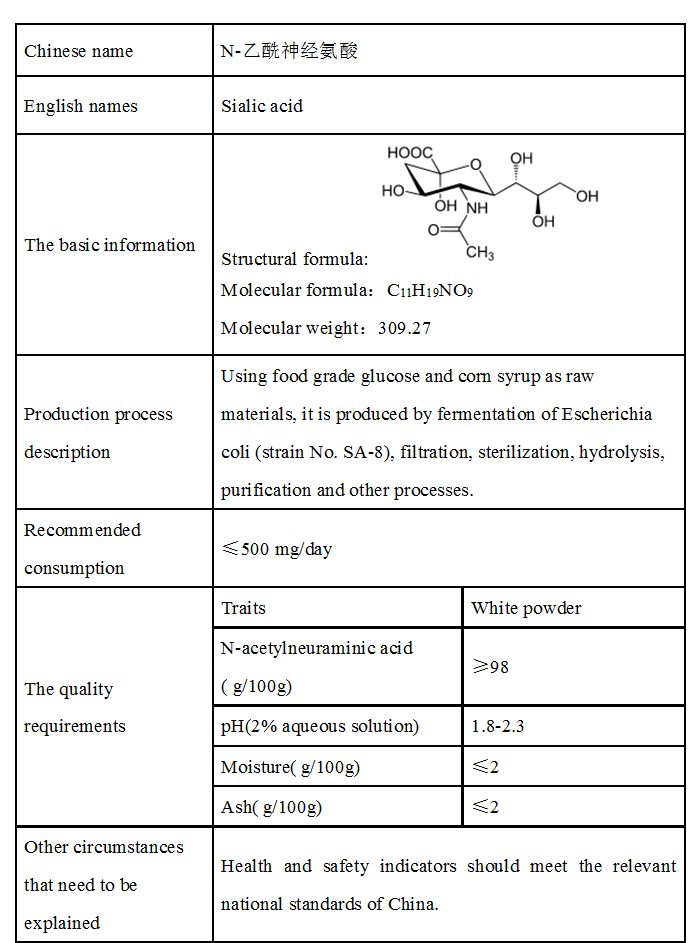In 2020, the Simba bird's nest sale incident triggered widespread discussion, one im
portant basis to determine the event is the sialic acid of Simba bird's nest in the test report is o
nly 1.4‱. However, the "Quality Grade of Bird's Nest" (GH/T 1092-2014) stipulates that the co
ntent of sialic acid in dry bird's nest should be at least 5%. The test results of Simba Bird's Nest violated above standard.
So, what is sialic acid? What is the function of sialic acid? What are the regulations on the application of sialic acid in various countries? To this end, Foodmate has compiled the relevant information of sialic acid , for your reference.
1. What is sialic acid
The scientific name of Sialic acid (SA) is "N-acetylneuraminic acid". It is a type of acidic nine-carbon mo
nosaccharide , which is the general name of all N- or O- derivatives of neuraminic acid or ketyl - deoxyno
nonose acid (KDN).
It was originally isolated from the protein hydrolysate in the bovine mandibular salivary gland by the scientist Gunnar Blix, so it was named sialic acid. As a kind of natural carbohydrate, it is widely distributed in the organism, and can form different polymers and complexes, which play an im
portant physiological function in the life activities of the organism. Its main food source is breast milk, but it is also found in bird's nest, cow's milk, goat's milk and cheese.
2. What is the function of sialic acid
In organisms, the ex
pression of genetic information is transmitted through DNA to RNA, and then from RNA to protein, thereby completing complex life activities. Moreover, sialic acid can complete the glycosylation modification of protein by binding with protein and lipid, and then exert biological effect. This "binding" is called sialic acid modification. ba
sed on the biological efficacy of sialic acid, it can be applied to food, health food, medicine and other fields.
In terms of food and health food, since sialic acid is an im
portant compo
nent of the structure and function of brain gangliosides and glycoproteins, it has a similar effect to DHA (docosahexaenoic acid). Therefore, it can be used as an im
portant supplement for the early development of infant brain. However, China does not have clear regulations on whether sialic acid can be used in baby food.
In terms of anti-virus, research has shown that sialic acid has a significant effect on anti-influenza virus, polyoma virus and rotavirus. The mechanism is : the process of virus infecting host cells, firstly through the sugar chain on the virus capsid adsorbed to the glycosyl receptors on the surface of the host cell, and most of these receptors have sialic acid terminal binding sites. The free sialic acid or its derivatives in the organism can prevent these bindings, thereby acting as an antiviral infection.
In terms of immunity, since sialic acid is not degraded by digestive enzymes in the intestine, and glycoproteins have a good auxiliary effect on resisting pathogens, and can improve the ability of the immune system to recognize viruses and bacteria, so it has a certain effect on the entire immune system of the organism.
3. What is the basis for the application of sialic acid
As early as 2017, the former Natio
nal Health and Family Planning Commission approved N-acetylneuraminic acid ( sialic acid) as a novel food material. So far, there is a legal basis for the application of sialic acid in China, and the requirements are as follows:
In 2020, the China Light Industry Council and the Ministry of Industry and Information Technology respectively issued opinions on the industry standard of N-acetylneuraminic acid. At the same time, the lead unit for standard formulation also issued a notice soliciting relevant information, so that the standard formulation of N-acetylneuraminic acid was officially put on the agenda.
In other mainstream countries/organizations, the European Unio
n has approved the use of N-acetyl-D-neuraminic acid as a novel resource food, and specified that it can be used in infant formula food, infant processed cereals food, infant food, and infant formula food for special medical purposes, etc. But so far, the United States, Australia and New Zealand, and Canada have not approved sialic acid as a food ingredient. Therefore, companies should use it in accordance with the country/region wher
e the product plans to sell in order to avoid violations carefully.
4. Summary
With the development of sialic acid standards in China and the in-depth study of sialic acid functions, it is expected that sialic acid will become a well-known raw material for the public and be widely used to improve the quality of our life in various fields in the future.
Please note: Original English article of Business Division of Food Safety and Regulatory Compliance of Global Foodmate, please indicate the source from the Global Foodmate if reprint.
Business Division of Food Safety and Regulatory Compliance of Global Foodmate provides food standards & regulations research, labelling compliance consulting/Chinese label design, industry public opinion monitoring and analysis, registration services (of Infant formula, FSMP, Health food, Novel Food Ingredients, Novel Food Additives, New Varieties of Food-Related Products and Overseas manufacturers of imported food) and other comprehensive food safety solutions for domestic and overseas enterprises and institutions in food industry.
Please feel free to contact us: +86 10 68869850, E-mail: global_info@foodmate.net


